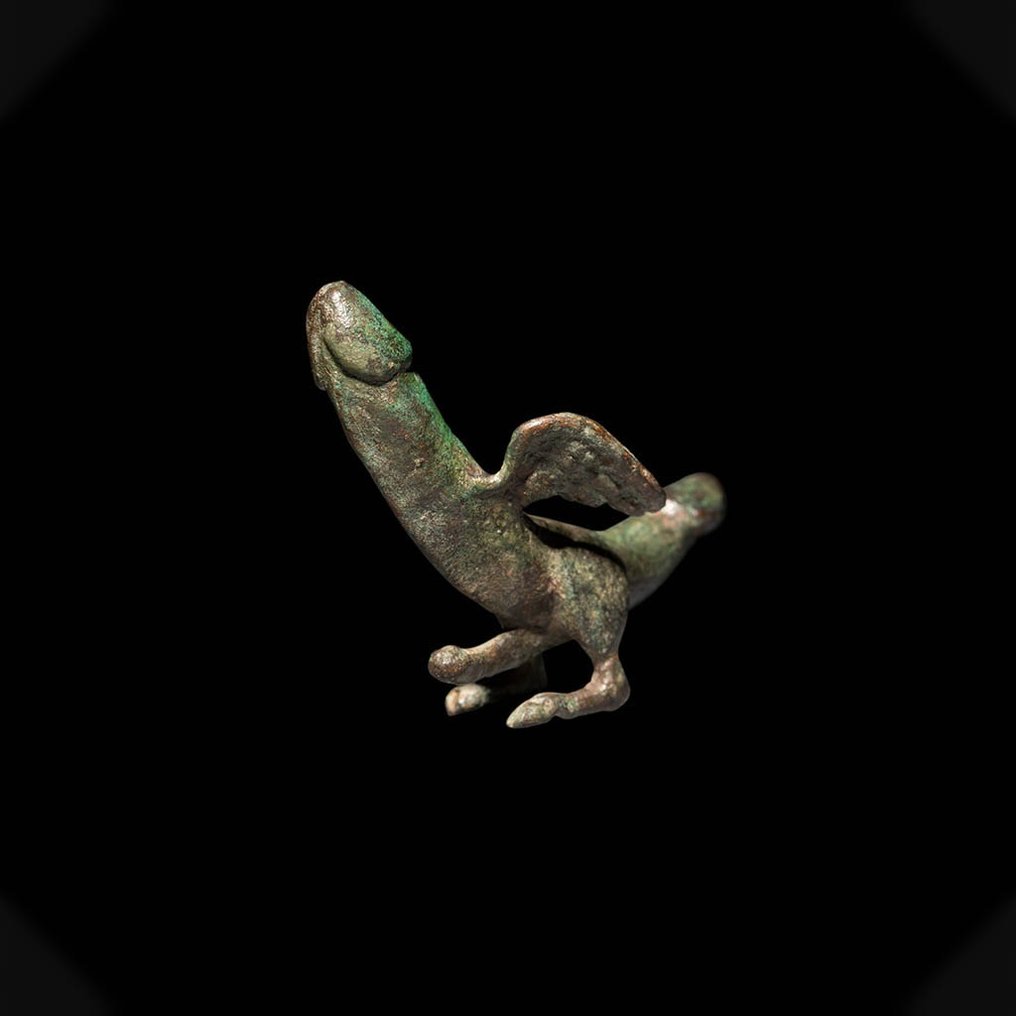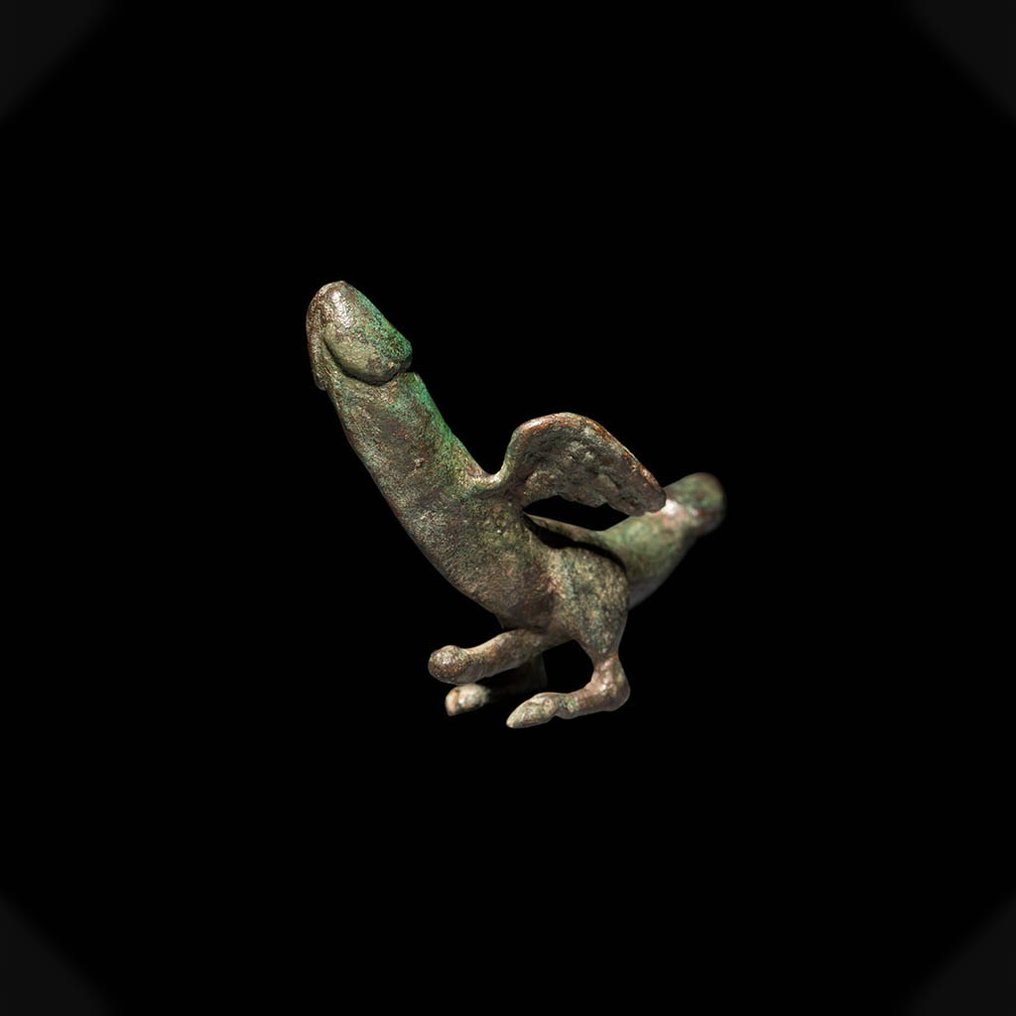Venditore eccellente. Articolo ben descritto e ben confezionato.
Ver traducciónAntigua Roma Bronce Amuleto fálico con alas. Siglo I-II d.C. Longitud 7,5 cm. Licencia de exportación española.
N.º 90344307



Phallic Amulet with Wings.
Ancient Roman, 1st - 2nd century AD.
MATERIAL: Bronze.
DIMENSIONS: 7.5 cm length.
PROVENANCE: Private collection, Great Britain. Acquired in the 1960s.
CONDITION: Good condition. Intact.
DESCRIPTION:
A triple phallic amulet representing a winged and erect male member, with two zoomorphic feet. At the same time, another smaller phallus can be seen between the lower limbs, and one more on a larger scale toward at the back of the first.
Sometimes named the “phallic bird” or “zoomorphic” phallus, the winged male sexual attribute was an habitual motif in Roman iconography, as it incorporated velocity, power, and rapidity. Numerous amulets of this type have been found throughout the Imperial realm, and helping to fill public and private collections.
This is a motif inherited from the Greek repertoire, as it symbolises the god Priapus, a minor divinity seen always with a permanent erection, an artistic resort with which to allude to the fecundity of nature, to abundance and harvests. At the same time, Priapus also had a role warding off the evil eye and protecting homes from thieves. This is the reason why the erect phallus appears on numerous amulets, oil lamps, statuettes and tintinnabula. The latter, generally made of bronze, were made up of a winged phallus from which wind chimes hung, and they were placed in gardens and porticos with the aim of protecting the property and bringing good fortune to the inmates. Various examples have been recovered from Pompeii, which testifies to the popularity of this fetish among the distinct social classes.
BIBLIOGRAPHY:
- Los bronces romanos en España. 1990. p. 251, figs. 167-169.
- GRANT. Eros in Pompeii, The Erotic Collection of the Museum of Naples. 1997. p. 139.
- JOHNS. Sex or Symbol? Erotic Images of Greece and Rome. 1990. n. 52.
PARALLELS:
Fig. 1. Tintinnabulum, bronze, from Pompeii, Museo Archeologico Nazionale di Napoli, inv. 27835.
Fig. 2. Christie’s, Sale 9050 New York, Ars Amatoria: The Haddad Family Collection of Erotic art, 17/12/1998, lot 68.
Fig. 3. Phallic tintinnabulum, bronze, length 10cm, British Museum n. 1865,1118.208.
Fig. 4. Phallic amulet, 2nd – 3rd century AD, length 5 cm, Museo Arqueológico y Etnológico de Córdoba, CE002885.
Fig. 5. Bronze amulet, 2nd - 3rd century AD, Kinský Palace, Praga, NM-H10 7087.
Notes:
- The piece includes authenticity certificate.
- The piece includes Spanish Export License (Passport for European Union) - If the piece is destined outside the European Union a substitution of the export permit should be requested, can take between 1-2 weeks maximum.
- The seller guarantees that he acquired this piece according to all national and international laws related to the ownership of cultural property. Provenance statement seen by Catawiki.
#ancientolympics
El vendedor y su historia
Phallic Amulet with Wings.
Ancient Roman, 1st - 2nd century AD.
MATERIAL: Bronze.
DIMENSIONS: 7.5 cm length.
PROVENANCE: Private collection, Great Britain. Acquired in the 1960s.
CONDITION: Good condition. Intact.
DESCRIPTION:
A triple phallic amulet representing a winged and erect male member, with two zoomorphic feet. At the same time, another smaller phallus can be seen between the lower limbs, and one more on a larger scale toward at the back of the first.
Sometimes named the “phallic bird” or “zoomorphic” phallus, the winged male sexual attribute was an habitual motif in Roman iconography, as it incorporated velocity, power, and rapidity. Numerous amulets of this type have been found throughout the Imperial realm, and helping to fill public and private collections.
This is a motif inherited from the Greek repertoire, as it symbolises the god Priapus, a minor divinity seen always with a permanent erection, an artistic resort with which to allude to the fecundity of nature, to abundance and harvests. At the same time, Priapus also had a role warding off the evil eye and protecting homes from thieves. This is the reason why the erect phallus appears on numerous amulets, oil lamps, statuettes and tintinnabula. The latter, generally made of bronze, were made up of a winged phallus from which wind chimes hung, and they were placed in gardens and porticos with the aim of protecting the property and bringing good fortune to the inmates. Various examples have been recovered from Pompeii, which testifies to the popularity of this fetish among the distinct social classes.
BIBLIOGRAPHY:
- Los bronces romanos en España. 1990. p. 251, figs. 167-169.
- GRANT. Eros in Pompeii, The Erotic Collection of the Museum of Naples. 1997. p. 139.
- JOHNS. Sex or Symbol? Erotic Images of Greece and Rome. 1990. n. 52.
PARALLELS:
Fig. 1. Tintinnabulum, bronze, from Pompeii, Museo Archeologico Nazionale di Napoli, inv. 27835.
Fig. 2. Christie’s, Sale 9050 New York, Ars Amatoria: The Haddad Family Collection of Erotic art, 17/12/1998, lot 68.
Fig. 3. Phallic tintinnabulum, bronze, length 10cm, British Museum n. 1865,1118.208.
Fig. 4. Phallic amulet, 2nd – 3rd century AD, length 5 cm, Museo Arqueológico y Etnológico de Córdoba, CE002885.
Fig. 5. Bronze amulet, 2nd - 3rd century AD, Kinský Palace, Praga, NM-H10 7087.
Notes:
- The piece includes authenticity certificate.
- The piece includes Spanish Export License (Passport for European Union) - If the piece is destined outside the European Union a substitution of the export permit should be requested, can take between 1-2 weeks maximum.
- The seller guarantees that he acquired this piece according to all national and international laws related to the ownership of cultural property. Provenance statement seen by Catawiki.
#ancientolympics
El vendedor y su historia
- 818
- 9
- 2
I'm absolutely happy with my purchase. The object is wonderful. Object as described, delivery was really fast
Ver traduccióntop 💯💯💯💯💯💯 come sempre :-)
Ver traducciónmatches with photos, excellent packaging, very quick delivery
Ver traducciónThe lamp is very beautiful and is in excellent condition. Professional packaging, complete documentation, very fast shipping. Thank you!
Ver traducciónA smooth transaction! Thank you!
Ver traducciónottimo venditore - fantastico oggetto
Ver traducciónLivraison rapide et lot très bien emballé.
Ver traducciónVery good
Ver traducciónTout est parfait
Ver traducciónVery quick shipment / excellent packaging / all the documents are inside. All very good 👍👏 Congrats and thank you !
Ver traducciónTodo perfecto
Ver traducciónWare sicher verpackt und schnell verschickt. Alles bestens!
Ver traducciónMuy buenos siempre … Bagot siempre es de confianza.
Ver traducciónI am really pleased with my purchase it's really lovely. It's beauty and quality exceed my expectations. The object was well wrapped and packed.
Ver traducciónGisteren niet ontvangen normal hebben ze mijn handtekening nodig doch lag bij de gebeuren ,eind goeg al goed😃😊
Ver traducciónbellissima ciotola etrusca top 💯💯💯💯💯💯💯💯 grazie :-)
Ver traducciónTodo bien
Ver traducciónMuy bien todo. Gracias
Ver traducciónPerfect
Ver traducciónThank you, everything was perfect!
Ver traducciónpiezas muy interesantes. Todo muy correcto, como siempre.
Ver traducciónestoy muy agradecida por como han tenido tanto tacto y cuidado en enviar la figura protegida, su certificado de autenticidad es muy profesional, al igual que su atención y trato con el cliente
Ver traducciónEl vendedor cumple lo prometido, el objeto es de alta calidad, entonces estoy muy satisfecho con mi compra, muchas gracias.
Ver traducción- 818
- 9
- 2
Venditore eccellente. Articolo ben descritto e ben confezionato.
Ver traducciónAviso legal
El vendedor garantiza y puede probar que el objeto ha sido obtenido legalmente. Catawiki ha informado al vendedor de que tenía que proporcionar la documentación exigida por las leyes y reglamentos de su país de residencia. El vendedor garantiza que tiene derecho a vender/exportar este objeto. El vendedor le proporcionará al comprador toda la información disponible sobre la procedencia del objeto. El vendedor garantiza que se tramitarán todos los permisos necesarios. El vendedor informará inmediatamente al comprador de cualquier retraso en la obtención de dichos permisos.
El vendedor garantiza y puede probar que el objeto ha sido obtenido legalmente. Catawiki ha informado al vendedor de que tenía que proporcionar la documentación exigida por las leyes y reglamentos de su país de residencia. El vendedor garantiza que tiene derecho a vender/exportar este objeto. El vendedor le proporcionará al comprador toda la información disponible sobre la procedencia del objeto. El vendedor garantiza que se tramitarán todos los permisos necesarios. El vendedor informará inmediatamente al comprador de cualquier retraso en la obtención de dichos permisos.